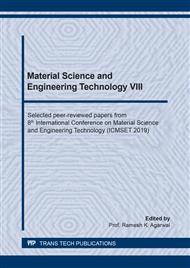p.78
p.84
p.90
p.96
p.102
p.108
p.114
p.123
p.134
Characterization of Low-Pressure Nitrogen Plasma Discharge and Pre-Oxidation on the Surface Characteristics of Activated Carbons
Abstract:
Commercial activated carbon (CAC) was modified using low-pressure radio frequency nitrogen plasma discharge (NPD) operating at 0.3 mbar and 40 kHz. The surface chemistry of CAC was modified using HNO3 pre-oxidation to possibly influence the reactivity of NPD. The results of x-ray photoelectron spectroscopy (XPS) suggested that pre-oxidation reduces aromaticity, generates aliphatic carbons (C-C and C-H), and increases carboxylic functional groups (COOH) which probably enhances the nitrogen plasma functionalization based on the N/C ratio for CAC-O-P (4.29 %) compared to CAC-P (2.88 %). FTIR was used to confirm such effects of pre-oxidation from the functional groups present on the carbon surface. The total surface area was identified using Langmuir and Brunauer–Emmett–Teller (BET) N2 adsorption isotherms at 77 K. Both pre-oxidation and plasma treatment caused an increase in the surface area of CAC up to 150 percent. Carbon t-plot method was used to determine the micropore volume, micropore area, and external surface area. The total surface area of each activated carbon was mostly constituted of micropore area which was identified to be directly proportional to the micropore volume. Scanning electron microscope (SEM) confirms the destruction of the surface morphology for CAC-O that might have caused the increase in surface area. Development of surface threadlike structures were observed for the NPD treated CAC-O. NPD favors the development of NH2 functionalities and reduces the aromaticity of activated carbons while enhancing the surface morphology and the surface area.
Info:
Periodical:
Pages:
102-107
Citation:
Online since:
June 2020
Price:
Сopyright:
© 2020 Trans Tech Publications Ltd. All Rights Reserved
Share:
Citation:


